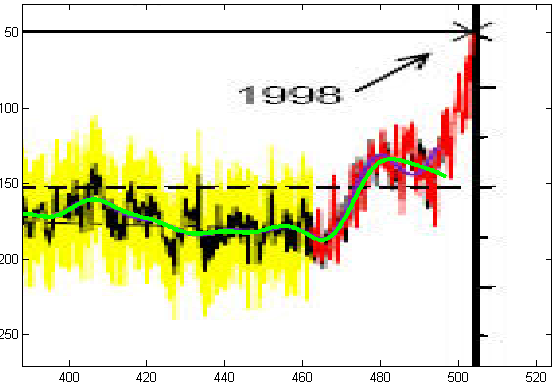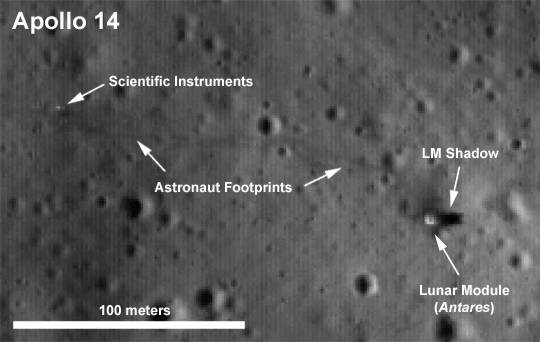It looks like the Mythbusters tend to ignore air resistance.
In a recent episode, they claimed to have demonstrated that a horizontally fired bullet and a bullet that is simply dropped fall to the ground in the same amount of time. They were wrong. What they actually demonstrated is that air resistance causes the fired bullet to hit the ground more slowly.
Their argument would apply perfectly in a vacuum, as on the surface of the Moon, but not here on the Earth, where the bullet’s motion is governed not just by the laws of gravity, but also by the laws of a non-conservative force, namely air resistance. (Why is it non-conservative? Some of the bullet’s kinetic energy is converted into heat, as it travels through the air at high speed. Unless we also include the thermodynamics of the air into our equations of motion, the equations will not conserve energy, as the amount of kinetic energy converted into heat will just appear “lost”.)
The bullet’s velocity, v, can be written as v2 = vh2 + vv2, where vh is the horizontal and vv is the vertical component. The initial horizontal velocity is v0. The initial vertical velocity is 0.
Air resistance is proportional to the square of the bullet’s velocity. To be precise, acceleration due to air resistance will be
aair = κv2,
where κ is an unknown proportionality factor. (To be more precise, κ = ½cAρm, where c is the dimensionless drag coefficient, A is the bullet’s cross-sectional area, ρ is the density of the air, and m is the bullet’s mass.) The direction of the acceleration will be opposite the direction of the bullet’s motion.
The total acceleration of the bullet will have two components: a vertical component g due to gravity, and a component aair opposite the direction of the bullet’s motion.
The resulting equations of motion can be written as:
dvh/dt = –κvvh,
dvv/dt = g – κvvv.
Right here we can see the culprit: air resistance not only slows the bullet down horizontally, it also reduces its downward acceleration.
This is a simple system of two differential equations in the two unknown functions vh(t) and vv(t). Its solution is not that simple, unfortunately. However, it can be greatly simplified if we notice that given that vv << vh, v ≅ vh, and therefore, we get
dvh/dt = –κvh2,
dvv/dt = g – κvvvh.
This system is solved by
vh = 1/(κt + C1),
vv = vh[(½κt2 + C1t)g + C2].
Given
v0 = 1/(κt0 + C1)
we have
C1 = 1/(v0 – κt0),
which leads to
vh = v0/[κ(t – t0)v0 + 1],
or, if we set t0 = 0,
vh = v0/(κtv0 + 1),
Similarly, given vv(0) = 0, we get C2 = 0, thus
vv = gt(κv0t + 2)/(2κv0t + 2).
The distance traveled horizontally (sh) and vertically (sv) between t0 = 0 and t1 can be obtained by simple integration of the respective velocities with respect to t between 0 and t1:
sh = log(κv0t1 + 1)κ,
sv = g[κv0t1(κv0t1 + 2) – 2log(κv0t1 + 1)]/(2κv0)2.
The claim by the Mythbusters was that the time it took for the fired bullet to hit the ground was only ~40 ms more than the time it took for a dropped bullet to fall, which is a negligible difference. But it is not! Taking g ≅ 10 m/s2, it is easy to see that the time it takes for a bullet to fall from a height of 1 m, using the well-known formula ½gt2, is 447 ms; the difference measured by the Mythbusters is nearly 10% of this number!
Not only did the fired bullet take longer to hit the ground, the Myhtbusters’ exquisite setup allows us to calculate the bullet’s initial velocity v0 and drag coefficient κ. This is possible because the Mythbusters conveniently provided three pieces of information (I am using approximate numbers here): the length of the path that the bullet traveled sh ≅ 100 m), the height of the bullet at the time of firing (sv ≅ 1 m), and the time it took for the fired bullet to hit the ground. Actually, what they provided was the difference between the time for a fired vs. a dropped bullet to hit the ground, but we know what it is for the dropped bullet (and because it is never moving very rapidly, we can ignore air resistance in its case), so t1 = 447 + 40 = 487 ms. The solution is given by
κ = 0.0054 m–1,
v0 = 272.3 m/s.
Given a bullet cross-sectional area of A = 2 cm2 = 2 × 10–4 m2, an approximate air density of ρ = 1 kg/m3, and a bullet mass of m = 20 g = 0.02 kg, the dimensionless drag coefficient for the bullet can be calculated as c = 2κmAρ = 1.08, which is not at all unreasonable for a tumbling bullet. Of course the actual values of A and m may differ from the ones I’m using here, resulting in a different value for the dimensionless drag coefficient c.


